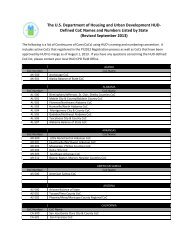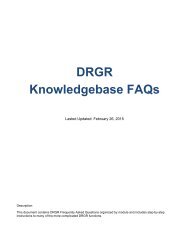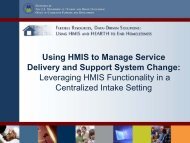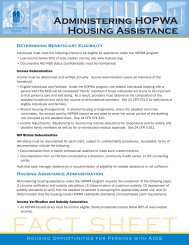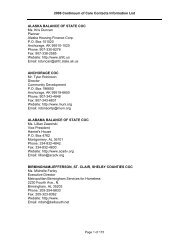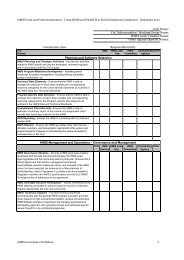HMIS Project Management Topics and Tools - OneCPD
HMIS Project Management Topics and Tools - OneCPD
HMIS Project Management Topics and Tools - OneCPD
- No tags were found...
You also want an ePaper? Increase the reach of your titles
YUMPU automatically turns print PDFs into web optimized ePapers that Google loves.
<strong>HMIS</strong> <strong>Project</strong> <strong>Management</strong> <strong>Topics</strong> <strong>and</strong> <strong>Tools</strong>User GroupsUser groups are a special kind of working group. User groups can serve similar workingfunctions as other groups: for example, they can help determine the most convenient data inputscreens. But they also serve to provide mutual support among users. They can answer eachother’s software questions <strong>and</strong> advise each other on “tips <strong>and</strong> tricks” for getting the most out ofthe software. Users will benefit by hearing about best practices <strong>and</strong> shared problems <strong>and</strong> are lesslikely to get frustrated with the system if a problem is shared <strong>and</strong> a solution is in the works. The<strong>HMIS</strong> initiative will benefit from greater data quality, hearing what is/is not working, <strong>and</strong>identifying users’ trouble with the system in a proactive manner. Regular user group meetingscan also be used to address critical topics <strong>and</strong> to help those users that are uncomfortable withcomputers <strong>and</strong> the Internet. User groups also are a time effective way to help advanced users tomaximize system functionality <strong>and</strong> effective use of data. Such groups can help relieve the projectstaff of help desk burdens <strong>and</strong> contributes to a sense of <strong>HMIS</strong> community. Appendix 25 isChicago’s user group m<strong>and</strong>ate.Consumer InvolvementHomeless <strong>and</strong> formerly homeless consumers should provide input to the planning,implementation, <strong>and</strong> operation of the <strong>HMIS</strong>. Consumers provide valuable insight aboutacceptable policies <strong>and</strong> practice <strong>and</strong> can help build a better solution <strong>and</strong> buy-in for that solution.If homeless consumers are educated about <strong>HMIS</strong> <strong>and</strong> realize its benefits, the <strong>HMIS</strong>implementation has a much greater chance of success. Consumers are often asked to help wordthe questions that are asked <strong>and</strong> to help draft <strong>and</strong> respond to policies <strong>and</strong> procedures. Consumersmight also be charged with creating a brochure that explains the <strong>HMIS</strong> to their peers. In the longrun,consumers can provide insight into the meaning of data that are produced from the <strong>HMIS</strong>.Some communities have established consumer working groups, <strong>and</strong> others include places forconsumers in their advisory <strong>and</strong> governing boards or in other working groups. Another approachis to hire consumers on the <strong>HMIS</strong> project staff. For communities that have had no consumerinvolvement, planning a consumer focus group could be an effective first step.State, Regional, <strong>and</strong> National <strong>HMIS</strong> ImplementersBeyond the primary <strong>HMIS</strong> stakeholders, the project manager will also need to managecommunication <strong>and</strong> relationships with other local, regional, <strong>and</strong> national <strong>HMIS</strong> groups. Asshown in Figure 5.4, the <strong>HMIS</strong> project staff has a foot in the broader group of <strong>HMIS</strong>implementers as well as the general local community, <strong>and</strong> serves as a liaison between them. Thissection focuses on working with other <strong>HMIS</strong> implementers, the following section focuses oninteracting with the general local community.42




